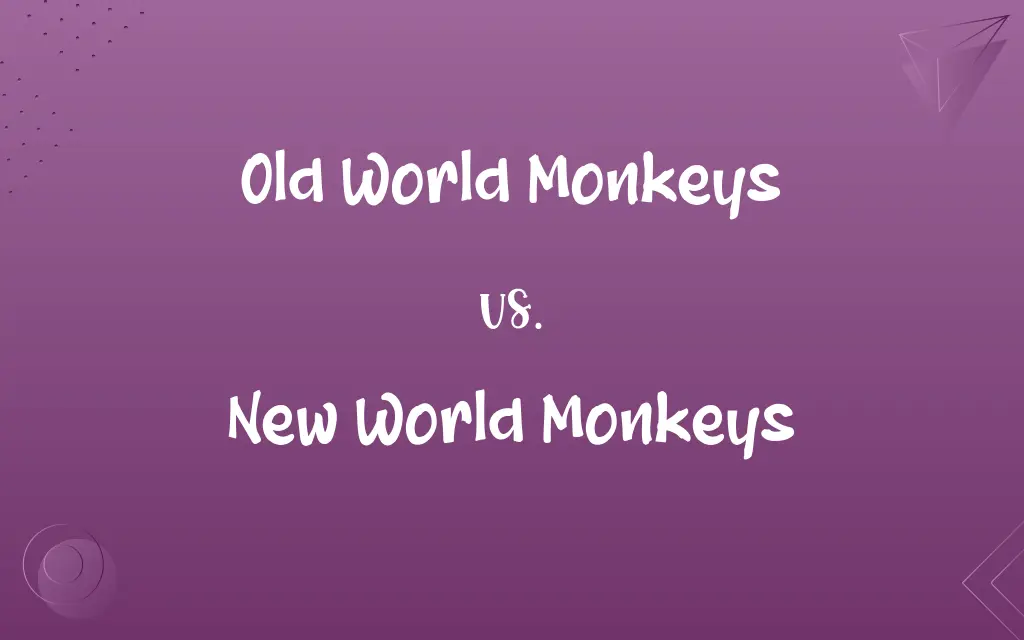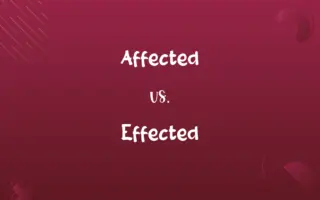Old World Monkeys vs. New World Monkeys: Know the Difference

By Shumaila Saeed || Updated on December 25, 2023
Old World Monkeys, native to Africa and Asia, have non-prehensile tails and narrower nasal separation, while New World Monkeys, from the Americas, often have prehensile tails and wider nostrils.

Key Differences
Old World Monkeys, found in Africa and Asia, are part of the Cercopithecoidea family. They are generally larger, have more robust bodies, and their nostrils are close together and point downward. New World Monkeys, belonging to the Platyrrhini family, are native to South and Central America. They are typically smaller, with flatter faces, and their nostrils are set further apart and often point sideways.
Shumaila Saeed
Dec 09, 2023
Regarding tail differences, Old World Monkeys usually have non-prehensile tails, which means they cannot use them for grasping. In contrast, many New World Monkeys have prehensile tails, a unique adaptation that allows them to grasp and hang from branches, aiding in their arboreal lifestyle.
Shumaila Saeed
Dec 09, 2023
Old World Monkeys often have sitting pads on their rumps, which New World Monkeys lack. This anatomical feature helps Old World Monkeys sit comfortably on branches or rocky outcrops. New World Monkeys, meanwhile, display a greater variety of tail types and often use them as an extra limb.
Shumaila Saeed
Dec 09, 2023
In terms of dental structure, Old World Monkeys typically have bilophodont molars, characterized by two ridges, which is not a feature in New World Monkeys. The dental formula also differs between the two groups, reflecting their varied diets and evolutionary paths.
Shumaila Saeed
Dec 09, 2023
Social structure and behavior also vary between Old World and New World Monkeys. Old World species often form large, hierarchical groups, while New World species exhibit more diverse social structures, including smaller, more egalitarian groups.
Shumaila Saeed
Dec 09, 2023
ADVERTISEMENT
Comparison Chart
Nostril Structure
Narrowly spaced, downward-pointing
Widely spaced, often sideways-pointing
Shumaila Saeed
Dec 09, 2023
Dental Structure
Bilophodont molars, specific dental formula
Different dental formula, varied molars
Shumaila Saeed
Dec 09, 2023
Social Structure
Often larger, hierarchical groups
More diverse, smaller groups
Shumaila Saeed
Dec 09, 2023
ADVERTISEMENT
Old World Monkeys and New World Monkeys Definitions
Old World Monkeys
Old World Monkeys have a more terrestrial lifestyle compared to their New World counterparts.
The African colobus, an Old World Monkey, spends considerable time on the ground.
Shumaila Saeed
Dec 01, 2023
New World Monkeys
New World Monkeys are arboreal primates from the Americas with prehensile tails.
The spider monkey, a New World Monkey, uses its prehensile tail to swing between trees.
Shumaila Saeed
Dec 01, 2023
Old World Monkeys
These monkeys often form large, complex social groups.
The gelada, an Old World Monkey, lives in large groups with intricate social dynamics.
Shumaila Saeed
Dec 01, 2023
New World Monkeys
They exhibit diverse social structures, often in smaller, egalitarian groups.
Squirrel monkeys, New World Monkeys, form close-knit, cooperative groups.
Shumaila Saeed
Dec 01, 2023
Old World Monkeys
Old World Monkeys are primates from Africa and Asia with downward-pointing nostrils.
The baboon, an Old World Monkey, is known for its strong social structure.
Shumaila Saeed
Dec 01, 2023
ADVERTISEMENT
New World Monkeys
These monkeys have a more varied dental formula and lack bilophodont molars.
New World Monkeys like the howler monkey have dental structures adapted to their diverse diets.
Shumaila Saeed
Dec 01, 2023
Old World Monkeys
Old World Monkeys possess non-prehensile tails and bilophodont molar teeth.
The macaque, a typical Old World Monkey, uses its non-prehensile tail for balance.
Shumaila Saeed
Dec 01, 2023
New World Monkeys
New World Monkeys lack sitting pads and have varied tail types.
Unlike Old World Monkeys, the capuchin, a New World Monkey, lacks sitting pads.
Shumaila Saeed
Dec 01, 2023
Old World Monkeys
This group is characterized by their sitting pads and larger body size.
Old World Monkeys like the mandrill have distinct sitting pads for resting on branches.
Shumaila Saeed
Dec 01, 2023
New World Monkeys
They are characterized by wide, sideways-pointing nostrils and smaller sizes.
The tiny tamarin, a New World Monkey, has distinct wide-set nostrils.
Shumaila Saeed
Dec 01, 2023
Repeatedly Asked Queries
Are Old World Monkeys typically larger than New World Monkeys?
Yes, they are generally larger.
Shumaila Saeed
Dec 09, 2023
Do Old World Monkeys have prehensile tails?
No, they have non-prehensile tails.
Shumaila Saeed
Dec 09, 2023
Are New World Monkeys more arboreal?
Yes, they are typically more tree-dwelling.
Shumaila Saeed
Dec 09, 2023
What type of social structure do New World Monkeys usually have?
Diverse, often smaller and more egalitarian groups.
Shumaila Saeed
Dec 09, 2023
Can New World Monkeys use their tails for grasping?
Many can, thanks to their prehensile tails.
Shumaila Saeed
Dec 09, 2023
Are there dietary differences between the two groups?
Yes, their diets vary due to different dental structures and habitats.
Shumaila Saeed
Dec 09, 2023
What kind of nostrils do New World Monkeys have?
Wide-set and often sideways-pointing.
Shumaila Saeed
Dec 09, 2023
Are Old World Monkeys more terrestrial?
Some species are more terrestrial compared to the mostly arboreal New World Monkeys.
Shumaila Saeed
Dec 09, 2023
Are Old World Monkeys more diverse in tail types?
No, New World Monkeys exhibit greater variety in tail types.
Shumaila Saeed
Dec 09, 2023
Do Old World Monkeys have wider nasal separation than New World Monkeys?
No, their nostrils are closer together and point downward.
Shumaila Saeed
Dec 09, 2023
Do New World Monkeys have bilophodont molars?
No, they lack bilophodont molars.
Shumaila Saeed
Dec 09, 2023
What is a unique adaptation of many New World Monkeys?
The ability to use their tails as an extra limb.
Shumaila Saeed
Dec 09, 2023
Do Old World Monkeys form large social groups?
Yes, they often form large, complex groups.
Shumaila Saeed
Dec 09, 2023
What is the dental formula difference between the two?
Old World Monkeys have a specific dental formula, while New World Monkeys have a more varied one.
Shumaila Saeed
Dec 09, 2023
Do Old World Monkeys have flatter faces than New World Monkeys?
No, it's the other way around.
Shumaila Saeed
Dec 09, 2023
Do New World Monkeys form hierarchical groups like some Old World Monkeys?
Their social structures are less hierarchical and more varied.
Shumaila Saeed
Dec 09, 2023
Share this page
Link for your blog / website
HTML
Link to share via messenger
About Author
Written by
Shumaila SaeedShumaila Saeed, an expert content creator with 6 years of experience, specializes in distilling complex topics into easily digestible comparisons, shining a light on the nuances that both inform and educate readers with clarity and accuracy.









































































